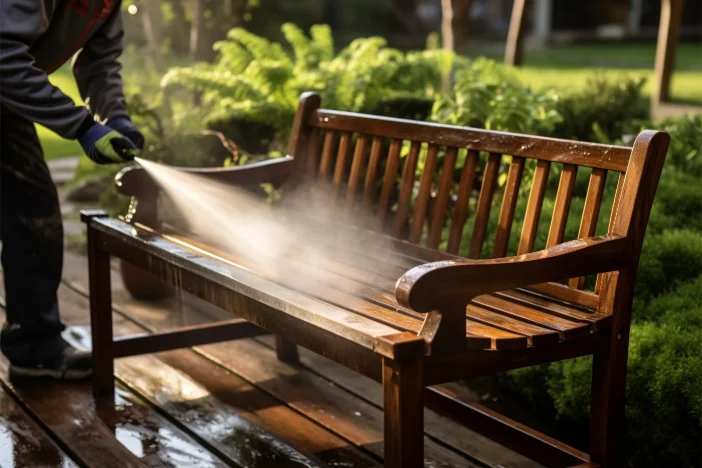
By now, you are well-versed in selecting the perfect materials to match your aesthetic, climate and budget. But owning beautiful patio furniture is only half the battle. The true test lies in maintaining its charm and longevity.
The usable life of your outdoor furniture can be extended by keeping it clean and well-cared for during and after the summer months. Each material has specific instructions for cleaning various types of spills, repairing damage and protecting it from the ravages of the wind, rain and sun. And, performing regular maintenance is much easier than a period deep clean.
In this final section of our outdoor materials guide, we cover how to maintain outdoor furniture so it lasts.
How to keep outdoor furniture clean
Whether it’s a scorching summer sun, relentless rain or the frigid cold, your deck furniture faces harsh elements year-round. Without the proper maintenance and care, your outdoor fabrics and materials could fade or rust.
These are general tips on how to take care of outdoor furniture. However, consult manufacturers’ manuals for the best care of your specific products.
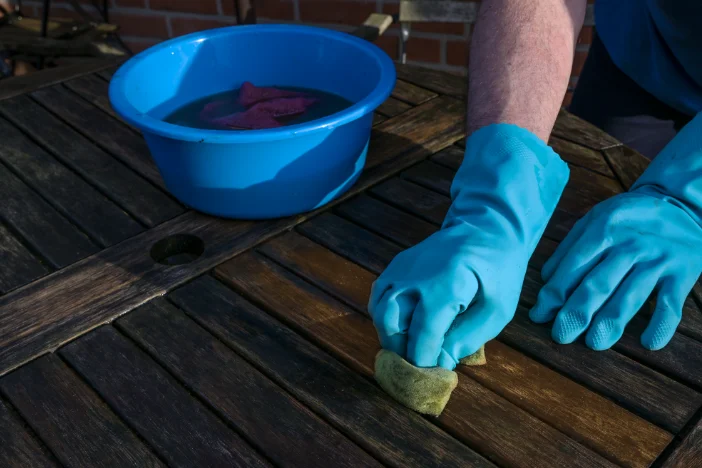
Hardwoods
If properly sealed and periodically treated, these sturdy woods will last a long time and develop a nice patina but some hardwoods may warp or crack if not protected.
Most wooden garden tables and seating are made from hardwoods, which can be cleaned and maintained similarly:
- Use a soft nylon bristle brush to remove light debris.
- Clean the surface with a sponge or damp cloth using mild household soap and lukewarm water.
- Soak up any excess water with a microfiber or lint-free cloth.
- Allow the wood to dry naturally.
Teak is extremely hardy and is known for developing a silvery gray patina. It requires very little maintenance, but you may want to apply a protective sealant to preserve its natural color and prevent mold.
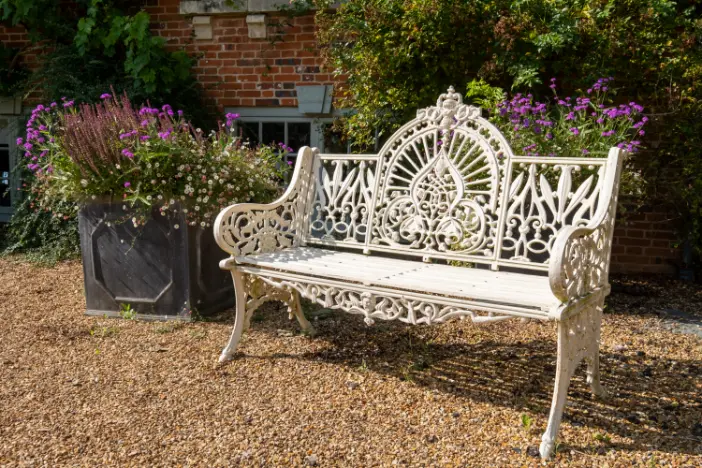
Metals
Metal patio furniture looks stunning when new but can become an eyesore if neglected and allowed to rust or stain. Most frames can be cleaned with these simple steps:
- Remove any upholstered cushions or decorative throw pillows.
- Lightly spray the metal outdoor furniture frames with a garden hose to wash away the larger pieces of dirt and debris.
- Wipe the metallic surfaces down using a soft cloth soaked in soapy water.
- Rinse the cloth and repeat wiping with clean water.
- Dry with a microfiber or low-abrasion cloth.
Of course, each type of metal has unique characteristics and requires specific care. Here are some tips for maintaining different types metal furniture.
Aluminum
Remember, powder-coated versions will do well in all environments but may be a bit lightweight for extremely windy conditions (cast or wrought aluminum is better). It’s prone to getting dented or scuffed, so be cautious when moving furniture and use a non-abrasive liquid cleaner to clear any scuffs. Powder-coatings are colorfast, so there should be little fading from UV rays.
Stainless Steel
Its high density, weight and strength make this metal great for outdoor tables in most climates and it resists corrosion the higher the chromium content or if powder-coated, although it does get hot in the sun.
Stainless steel may rust or get hard water stains over time. Regular cleaning helps avoid this and spot treatments can further help remove any unsightly stains.
Wrought Iron
This extremely heavy material can last a century if properly cared for, but it does require a lot of TLC to clean and protect from rusting. If your wrought iron balcony furniture has rust or chipped paint, you’ll need to get rid of that before cleaning.
Plastics
Plastic is lightweight, fade-resistant, and versatile, easily taking on various shapes, textures, and styles. Unlike other materials, it doesn’t need paint or sealants, making it an easy-to-maintain and cost-effective choice for outdoor furniture. Cleaning and caring for synthetic furniture largely depends on its form.
For sticky spills and drips like tree sap, commercial products (e.g., Goo Gone) may be necessary, although rubbing alcohol often works well. Whatever solution you use, it’s crucial to rinse it off immediately after cleaning the problem areas.
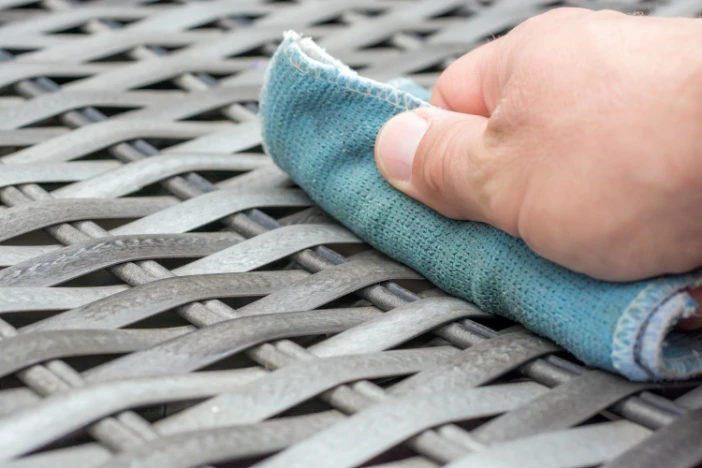
Resin Wicker
HDPE wicker is extremely strong and will resist damage from moisture, high temperature and UV rays, although it may blow away if not weighted down in high wind locations. Cleaning the nooks and crannies in intricate resin wicker patio furniture does take a little effort though.
- Remove all pillows and cushions.
- Use a soft-bristled brush to get rid of superficial debris.
- Any additional leaves, twigs, soil or other material that may have become lodged in the weave can usually be taken care of using a vacuum with a small brush attachment.
- If you still have fine debris lodged in deep or intricate weaves, you can employ a high-pressure washer set at a low or moderate level.
- Once the wicker is free of superficial dirt, use the hand brush with mild household soap and lukewarm water to gently scrub the surface clean of any stains.
- Rinse the woven material well.
- Air-dry the furniture in the shade.
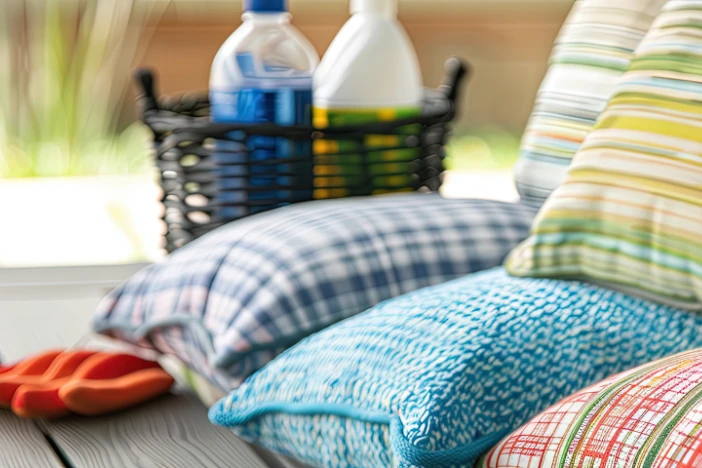
How to clean patio furniture fabric
Fabrics are the other part of the equation. While they generally require minimal maintenance, there are a few tips to keep them in excellent condition.
Some removable covers can be cleaned in the washing machine, but cleaning them by hand is also very easy. Non-removable covers can also be cleaned with a high-pressure hose and ample time to allow the cushions to air dry. You can also spot clean fabrics as needed.
How to prevent mold on outdoor upholstery cushions
While most outdoor fabrics are resistant to fungus growth, regular cleaning can help ensure mold doesn’t accumulate. Here are the five easy steps to help prevent mold or mildew on your outdoor cushions:
- Prepare a solution using one cup of bleach, ¼ cup of mild detergent, and a gallon of water.
- Spray the stained area, allowing it to soak into the fabric for about 15 minutes.
- Using a soft-bristled brush, sponge, or towel, clean the entire area until the stain is gone.
- Rinse the fabric thoroughly to remove any remaining soapy residue.
- Air dry until the cover is completely moisture-free.
Helpful Article
Read our complete Patio Furniture Cleaning & Care Guide to learn more about maintaining different outdoor materials.
Final thoughts
Throughout this guide, we’ve explored a wide array of materials, from the timeless elegance of wood to the modern durability of high-tech textiles. We’ve provided practical advice on how to care for each type of furniture, ensuring they remain beautiful and functional for years to come. It goes without saying, that keeping patio furniture covered when not in use or in inclement weather will help as well.
With the knowledge you’ve gained, you’re well-equipped to create and maintain an outdoor space that reflects your style and withstands the test of time. Start creating your curated outdoor haven with stunning luxury patio furniture from Decor Outdoor.

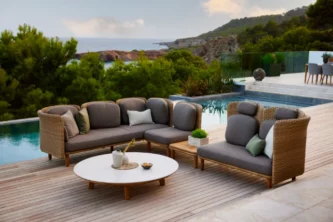
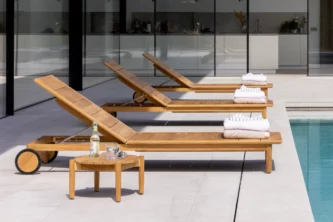
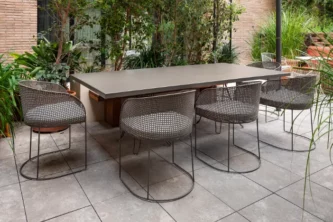
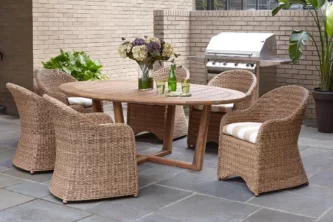
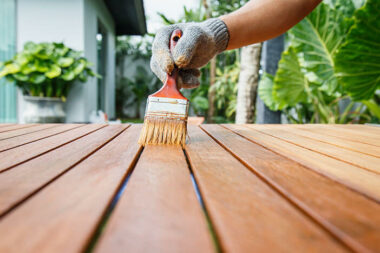
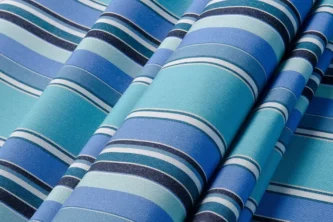
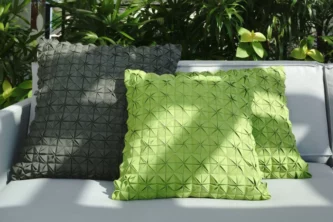




Leave a Reply